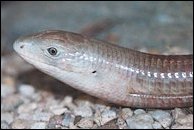
Everyone knows how to tell a snake—it doesn't have any legs! Just goes to show that what "everyone knows" requires a bit of skepticism. It's true that snakes don't have legs, but neither do some lizards and some amphibians. I can almost hear it now: "But if it's a reptile and doesn't have legs, it really has to be a snake." There's another bit of folk advice here that's apres pos: "Don't judge a book by its cover".
Biologists long ago learned to look deeper. After all, we classify
organisms by their evolutionary relationships, not looks alone. Strip off the flesh of
a lizard's head, and we have a quite solid skull and jaw. Do the same thing to a
snake, and we're practically dealing with a mobile. An absent stabilizing bar of
bone, movable skull bones, and extraordinarily loose joints interact to allow snakes to
swallow prey bigger around than their heads—something you'll never find a
conservative lizard trying. Relax, though—our Chihuahuan Desert lacks legless
lizards and amphibians—if it doesn't have legs, it's a snake! 
Contributor: Arthur H. Harris, Laboratory for Environmental Biology, Centennial Museum, University of Texas at El Paso.
Desert Diary is a joint production of the Centennial Museum and KTEP National Public Radio at the University of Texas at El Paso.

European Glass Snake. Note the ear opening, which will separate these lizards from snakes (as will eyelids). Photograph by John White.
![]()
Conant, R. 1958. A field guide to reptiles and amphibians. Houghton Mifflin Co., Boston. 366 pp.
Ophisaurus attenuatus, Illinois Natural History Survey.
Ophisaurus attenuatus, University of Michigan Museum of Zoology.
![]()